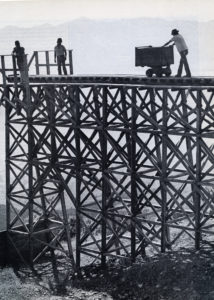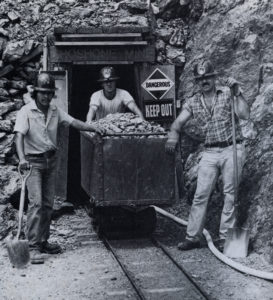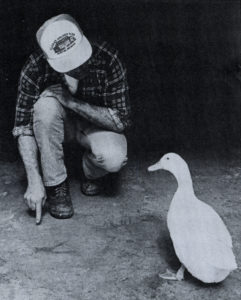Yesterday: The Case of the Sky High Prospector
Winter 2022-2023
Al Lombardo came to Austin a century too late, but through luck and pluck he’s proved that Nevada is still the land of opportunity.
BY RICHARD MENZIES
The question is, can a down-and-out Italian kid from the streets of New York come out West, stake his claim on the thoroughly picked over mineral belt of Central Nevada, and live happily ever after in the almost ghost town of Austin?
Back in the territorial days when New York Tribune publisher Horace Greeley issued his famous injunction, “Go West, young man,” the answer would likely have been yes. But that was more than a century ago, and the prospects didn’t seem so bright in the summer of 1969 when Al Lombardo hit town with precious little mining experience under his belt and 17 cents in his pocket. Fresh out of the Marine Corps, he had spent some time prospecting for gold in Alaska and was knocking around Nevada when his pickup truck broke down in Austin.
“I didn’t have enough money to tix it,” recalls the 37-year-old Lombardo. “But I guess when you’re down and out of luck, When you hit bottom, you start pullin’ rabbits out of hats. That’s when you work best.”
After looking for regular employment without much success, Al decided to strike out on his own as a self-employed prospector. Ed and Louise Vigus at the hardware store agreed to stake him with a pick and shovel, and for the most part he subsisted on a diet of spaghetti and beans while peddling his nuggets and rocks passersby from a humble roadside shop.
“I remember my first building was from Montgomery Ward’s. It was 28 feet long, eight feet wide, and I think five and a half feet high. That was my first shop; I couldn’t afford any more than that. It blew away in the wind. Then I had my lapidary equipment all out in the open, but that following fall I scraped up enough money to put up a better one
Fifteen years later, the Lombardo Milling and Mining Company appears to be in no danger of being carried off by the wind. Today the complex situated on Austin’s main street includes a gemstone and jewelry showroom, a lapidary workshop and laboratory, and a three-bay maintenance garageable painted in deep blue color of number one turquoise. Beside the front entrance stands an antique ore cart flanked by assorted cacti and prickly pear and a sign bearing the somewhat superfluous warning to keep out of the garden. In addition to the lethal shrubbery, the premises are protected by a nearsighted Doberman named Mutso and a duck by the name of Beatrice B. Blumberg.
“Beatrice is the eyes of our security system,” explains the proprietor. “Mutso provides the teeth.”
Lombardo, whose accent betrays his eastern urban uprising, is only half kidding when he talks about security. People around Austin haven’t exactly warmed to his brash manner and mile-a-minute pace, and some, he claims, are downright hostile. Lombardo was denied admission to the local chamber of commerce in 1976, and he’s still smarting from the effects of a police raid on his laboratory two years ago.
“They’re really paranoid here,” says Lombardo. “They thought I was making drugs or something! But besides that, I’ve done very well here, in spite of the problems I’ve had.”
What Lombardo makes in his laboratory is jewelry and rock clocks. He’s also masted a process for growing silver and gold crystals, which he markets in the form of pendants and earrings. But his main stock in trade is turquoise, which he mines, polishes, and fashions to bracelet\s, rings, and necklaces with help from his friend and apprentice Danielle Kohler. And while other retailers have complained of a slump in the turquoise market, Lombardo is typically bullish. The key to success lies in aggressive marketing, he says, citing DeBeers Consolidated Mines as an example.
“They did it with diamonds, an absolutely useless rock. The gem diamond’s absolutely worthless, but they advertised and they created their own market, and became the richest, most powerful, most influential, and most successful mining company in the world. And if DeBeers can do it, I can do it.”
The source of Lombardo’s optimism is a rock ledge located 9,000 feet above sea level in a nearby mountain range. He proudly calls his claim to the mother lode of Nevada Turquoise, and over the past decade it’s yielded over two million carats’ worth of sky-blue gemstone.
Because of its elevation, the mine is inaccessible during the winter and spring except by snowcat. In warmer months it can be reached by four-wheel-drive truck, courage, and an unwavering faith in Ford brakes. As he drove up with a visitor one day last summer, crawling skyward along the barest outline of a road, Lombardo enjoyed a bird’s eye view of falcons soaring over a convoluted landscape formed of dozens of neighboring mountaintops. Spectacular as the scene was, however, it proved to be just a prelude to the main event. Cresting a ridge, he and his passenger came suddenly upon a herd of at least a hundred wild horses, and watched transfixed as they galloped off in a thunder of hoofbeats down a distant cloudy draw. It was a breathtaking spectacle worthy of the big screen, wanting only a suitable soundtrack—perhaps a Vaughn Monroe rendition of “Ghost Riders in the Sky.”
In the midst of all this alpine splendor, Lombardo’s Shoshone Mine looks like a page torn from a book on the history of western mining. Emerging from the graceful portal, a narrow-gauge track runs out onto an old-fashioned wooden dump trestle overlooking the valley below. The mine’s rolling stock consists of a single 18-gauge dump car an da tool cart loaded with dynamite. About all that is missing from the picture is a cantankerous proprietor in a beard and slouch hat, ruminating on a plug of Mail Pouch chewing tobacco. Although Al Lombardo doesn’t match the description, neither does he mind the comparison.
“The old-timers, they knew what they were doing,” he says. “I have to admit it, I’m not a very good miner, but these old-timers who worked with that star drill, single jack, and stuff, it was an art in itself. Archaic as hell, but in a high-grade mining operation it’s still the most efficient way to go.”
Except for his pneumatic drill and dynamite, Lombardo admits he still mines “like they did 8,000 years ago. You gotta understand, I don’t produce like these big mines. I produce handfuls a day of fine material, all hand sorted.”
Lombardo is especially pleased with his wooden dump trestle, which he and assistant Gib Bleazard put together in the summer of 1979. Although such structures were common in Comstock days, he says it’s impossible today even to find plans. Lombardo’s trestle is patterned after pictures he found in historical journals.
Lombardo has also researched his claim’s history and prehistory. which is written in rock shards and primitive tools, and has determined that the ledge was once worked by Indians who used the blue gemstone for ornamentation and barter. In the early 1900s the prospect was unofficially worked by one Jerry Jackson, a Shoshone who also went by the name of Sontag. In 1969 the claim was officially located and registered as the Sotang Lode by prospectors who evidently couldn’t spell Sontag’s name right.
In 1972 Lombardo bought a half interest in the ledge from a local prospector and founded Lombardo Turquoise Milling and Mining Company, Inc. After moving 15 feet of rock, he was encouraged, and with the help of a financial partner he drilled several exploratory holes to a depth of 150 feet. The results seemed to bear out his suspicion that he was sitting on top of a rare hypogene, or deep, turquoise deposit.
Over the next two years, Lombardo was able to enlarge the pit to a depth of 80 feet. with proceeds from the recovered turquoise, he built up his jewelry business and eventually was able to buy out his partners, thus becoming sole stockholder in the mine. Then in 1975 he decided to convert to an underground operation and name it the Shoshone Mine in honor of its aboriginal finders.
Because the turquoise occurs in vertical fractures sandwiched between hard waste rock, the drilling and blasting process has been painstakingly slow. After 10 years the mine consists of a single adit, the North Star Tunnel, extending just 105 feet into the mountainside. Yet the mine remains profitable, owing as much to the resourcefulness of its owner as it does to the richness of the rock. Lombardo recently put himself through school and has become a registered gemologist. And even though he arrived on the scene a century after the big rush, he maintains that Nevada’s underground wealth is far from played out.
“Nevada is probably more wealthy than Burma, Ceylon, and Thailand—all the main gem producing centers of the world put together. People are sitting back in their armchairs wishing they could find a vein. But there’s a lot of minerals left. All you gotta do is dig them out and produce them.”
Al Lombardo has come a long way from the sidewalks of New York to a mountaintop in Nevada. Financially he’s in the black, but one gets the impression he values his independence and self-sufficient life style more than money.
“I think the mine itself is a symbol of what Nevada’s about,” he declares. “It’s right in the middle of the state, and mining’s what built this state. The miners came, they built their mines. The storekeepers and ranchers came to feed the miners, and gambling came later.
“I really love Nevada. I mean, I don’t consider myself an Easterner. I couldn’t survive in the city where you’re just a number and they don’t care who you are. Here, you’re still somebody. I’m probably living in the last of America. It’s the last frontier.”






